Perched atop a dramatic cliff overlooking the North Sea, Dunnottar Castle is one of Scotland’s most striking historical landmarks. This medieval fortress, steeped in history and legend, invites visitors to immerse themselves in tales of bravery, conquest, and resilience. Its stunning location near Stonehaven makes it a must-visit destination for history enthusiasts and nature lovers alike.
Getting to Dunnottar Castle
Dunnottar Castle is located at Stonehaven, AB39 2TL, UK, along Scotland’s rugged eastern coastline. The castle is most easily accessed by car, as it lies just 30 minutes south of Aberdeen and approximately two hours north of Stirling and Edinburgh. Travelers can reach it via the A92, which conveniently branches off from the A90.
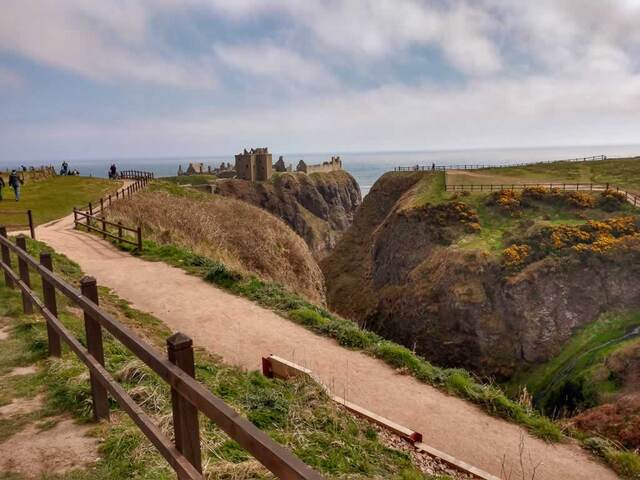
Upon arrival, visitors will find a stone-paved parking lot. Be mindful of traffic flow, as the small circular parking lot follows the opposite direction typical for right-side driving. For those traveling without a car, the journey to the castle can be challenging as bus or train services are limited. Renting a car is highly recommended to make the trip as seamless as possible.
Exploring Dunnottar Castle: A Walk Back in Time
The experience of visiting Dunnottar Castle begins with its breathtaking approach. The winding path leading to the castle offers stunning views of the surrounding cliffs, rocky shores, and rolling waves of the North Sea. For the best vantage points, consider taking the right fork in the trail, where a bird’s-eye view of the castle awaits.
As you walk along the main path to the left, a cascading waterfall tumbles down the hillside, adding a touch of natural beauty to the rugged terrain. However, reaching the castle requires a bit of effort—visitors must descend a steep pathway and climb a 160-foot ascent. While the trek is manageable, those who need a break can pause to take in the sights of the beach below or the majestic cliffs.
Inside the castle grounds, the exploration continues. Visitors will first encounter the Silver House, a prominent structure that serves as an introduction to the fortress’s open layout. From here, you are free to wander the grounds, stepping into stables and gazing at Old Hall Bay from its vantage points. A stroll across the Bowling Green offers sweeping views of the cliffs, while the ruins evoke a sense of the castle’s storied past.
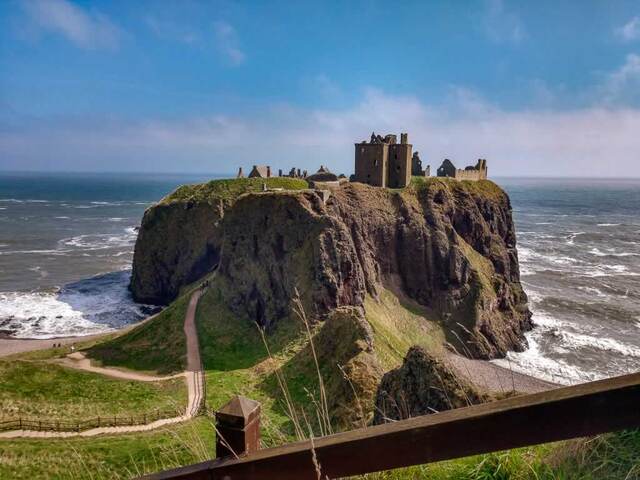
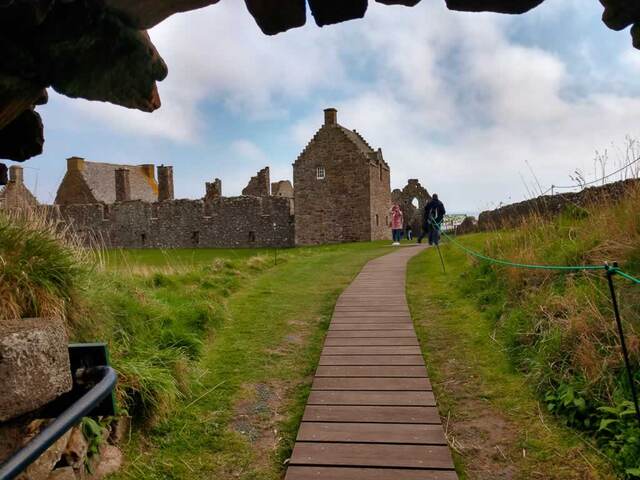
The History and Legacy of Dunnottar Castle
Dunnottar Castle’s history dates back to ancient times, when the land was part of the Pictish kingdom known as Pictavia. Its first documented event of significance occurred in the 10th century, when Viking raiders brutally murdered King Donald II on this very land.
The castle also played a key role in the Scottish Wars of Independence. In 1297, William Wallace reportedly recaptured the castle from English forces and burned 4,000 soldiers alive. While this grim episode is not depicted in Braveheart, it remains a poignant reminder of Scotland’s turbulent history.
The Keith family’s stewardship of Dunnottar began in 1359, when Sir Robert de Keith received the barony from Robert the Bruce. Over the years, the Keiths became protectors of the Honours of Scotland (the crown, sword, and scepter). During Oliver Cromwell’s campaign in 1651, the castle was used to safeguard these royal treasures. Although Cromwell’s forces laid siege to the fortress, the Honours were successfully smuggled out by Sir George Ogilvie and his wife, who later faced imprisonment for their defiance.
By the 18th century, the castle fell into disrepair. After George Keith, the 10th Earl Marischal, fled during the Jacobite Uprising, the state seized the castle, leading to its partial dismantling. However, restoration efforts in the 20th century, aided by historical postcards and illustrations, have preserved Dunnottar Castle as a cherished cultural landmark.
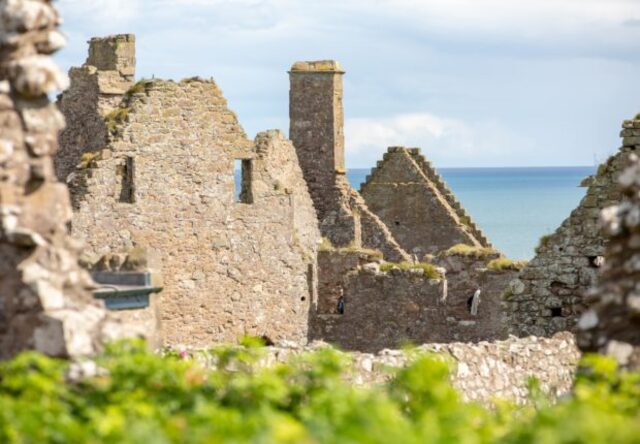
Planning Your Visit: Tips for a Memorable Experience
Dunnottar Castle is not only a historical treasure but also a practical destination with modern amenities. Upon arrival, visitors can purchase tickets for £7 (adults) or £3 (children). Keep in mind that the castle is privately owned, so Historic Scotland Explorer Passes are not valid here. To make your visit even more enjoyable, consider the following tips:
- Wear Comfortable Shoes: The steep climb and rugged paths require sturdy footwear.
- Bring a Picnic: While there is an on-site food vendor, packing a picnic allows you to enjoy a meal with unparalleled views of the cliffs and ocean.
- Plan for Weather: Scotland’s weather is famously unpredictable, so dress in layers and bring waterproof gear.
- Don’t Forget Your Camera: The castle’s location offers countless photo opportunities, from sweeping coastal views to intricate architectural details.
- Explore the Beach: If weather permits, take a walk down to the beach for a closer look at the shoreline and perhaps a chance to spot puffins.
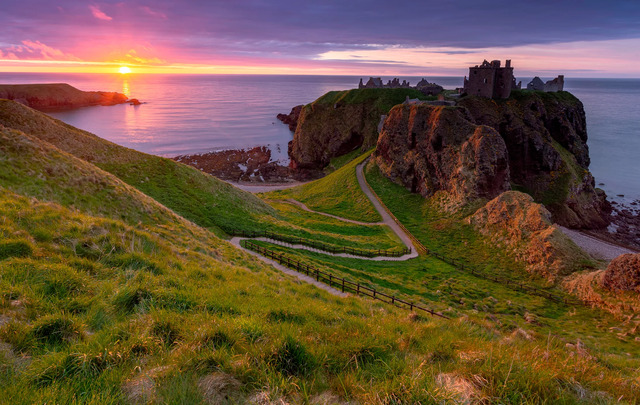
Why Dunnottar Castle Captivates Visitors
Dunnottar Castle is more than just a relic of the past; it is a living testament to Scotland’s resilience and cultural heritage. Its dramatic cliffside location has inspired filmmakers, with appearances in Hamlet and as an inspiration for Disney Pixar’s Brave. The fortress’s historical significance, from its role in the Wars of Independence to its protection of the Honours of Scotland, makes it a symbol of bravery and ingenuity.
Moreover, the castle’s restoration showcases the dedication of conservationists and local communities. Thanks to their efforts, visitors today can walk through centuries of history while marveling at the natural beauty that surrounds this iconic site.
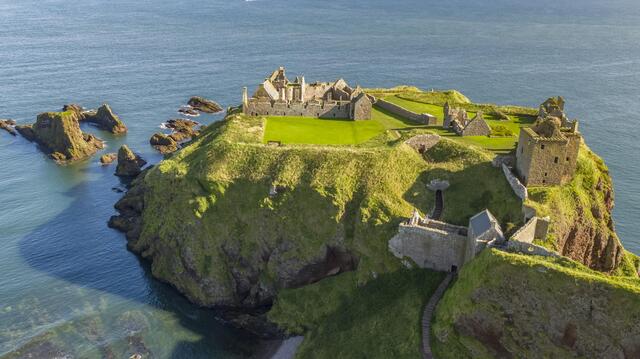
Conclusion
Dunnottar Castle is a destination that seamlessly blends history, nature, and adventure. From its storied past to its breathtaking views, it offers an unforgettable experience for all who visit. Whether you’re a history enthusiast or simply seeking a unique travel destination, Dunnottar Castle is a place where Scotland’s rich heritage comes to life. Don’t miss the chance to explore this extraordinary landmark—you’ll leave with memories as timeless as the castle itself.
